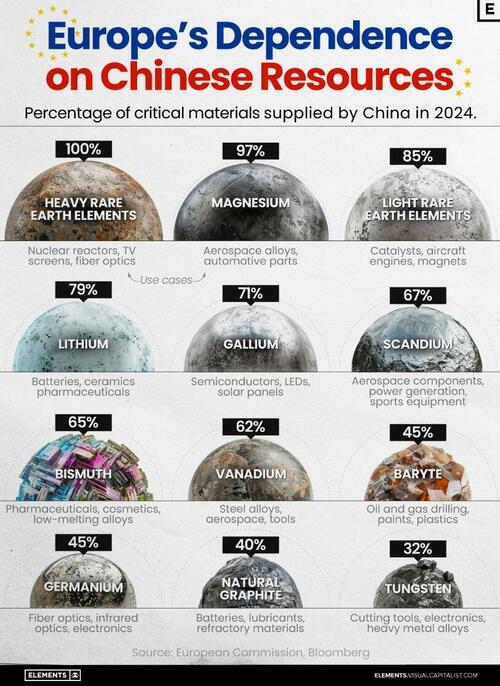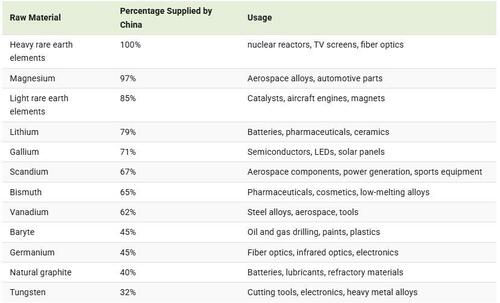Authored by Mark Whitney,
The future of humanity is being decided as we speak. And it is not being decided on a battlefield in Eastern Europe, or the Middle East or the Taiwan Strait, but in the data centers and research facilities where technology experts create “the physical and virtual infrastructure to power the next generation of Artificial Intelligence.”

This is a full-blown, scorched-earth free-for-all that has already racked up a number of casualties though you wouldn’t know it from reading the headlines which typically ignore recent ‘cataclysmic’ developments. But when President Trump announced the launching of a $500 billion AI infrastructure project (Stargate) on Tuesday just hours after China had released its DeepSeek R1—which “outperforms its rivals in advanced coding, math, and general knowledge capabilities”—it became painfully obvious that the battle for the future ‘is on’ in a big way. And this is not a battle that either side can afford to lose. Here’s how technology expert Adam Button summed it up:
Imagine we’re back in 2017 and the iPhone X was just released. It was selling $999 and Apple was crushing sales and building a wide moat around its ecosystem.
Now imagine, just days later, another company introduced a phone and platform that was equal in every way if not better and the price was just $30.
That’s what unfolded in the AI space today. China’s DeepSeek released an opensource model that works on par with OpenAI’s latest models but costs a tiny fraction to operate. Moreover, you can even download it and run it free (or the cost of your electricity) for yourself.
The product is a huge leap in terms of scaling and efficiency and may upend expectations of how much power and compute will be needed to manage the AI revolution. It also comes just hours before Trump is expected to unveil a $100 billion investment in US datacenters. The model shows there are different ways to train foundational AI models that offer up the same results with much less cost. It also opens up far more applications for AI that would have been too expensive to run previously, which should broaden the applications in the real economy.
– China’s DeepSeek may have just upended the economics of AI, forex live

Imagine the panic that is spreading across western tech capitals right now. AI was supposed to be the fast-track to absolute societal control and oligarchic rule into the next millennia, but now those pesky Chinese have overturned the applecart leaving western elites with a problem they might not be able to fix. (See—Unchecked AI will lead us to a police state, edri ) They expected that their microchip sanctions would sabotage China’s AI efforts for at least a decade-or-so but, instead, China has come roaring back with a system that has left the tech giants gasping for air.
Of course, China’s eye-popping strides in technological development are nothing new as editor Ron Unz pointed out in a recent article where he noted that “between 2003 and 2007, the US led in 60 of the 64 technologies.” Whereas, as of 2022, “China led in 52 of the 64 technologies.” That’s not a competition; that’s a beat-down in a parking lot. Here’s Unz:
China now leads the world in many of the most important future technologies. The success of its commercial companies in telecommunications (Huawei, Zongxin), EV (BYD, Geely, Great Wall, etc.), battery (CATL, BYD) and Photovoltaics (Tongwei Solar, JA, Aiko, etc.) are directly built on such R&D prowess.
Similarly, the Chinese military’s modernization is built on the massive technological development of the country’s scientific community and its industrial base…. With its lead in science and technology research, China is positioned to outcompete the US in both economic and military arenas in the coming years…. American Pravda: China vs. America, Ron Unz, Unz Review
None of this should come as a surprise, although the timing of DeepSeek’s release (preempting Trump’s Stargate announcement) shows that the Chinese don’t mind throwing a wrench in Washington’s global strategy if it serves their regional interests, which it undoubtedly does. Here’s a bit more background from an article by Benj Edwards at Ars Technica:
On Monday, Chinese AI lab DeepSeek released its new R1 model family under an open MIT license, with its largest version containing 671 billion parameters. The company claims the model performs at levels comparable to OpenAI’s o1 simulated reasoning (SR) model on several math and coding benchmarks….
The releases immediately caught the attention of the AI community because most existing open-weights models—have lagged behind proprietary models like OpenAI’s o1 in so-called reasoning benchmarks. …
The R1 model works differently from typical large language models ….They attempt to simulate a human-like chain of thought as the model works through a solution to the query. This class of what one might call “simulated reasoning” models, or SR models for short, emerged when OpenAI debuted its o1 model family in September 2024. …
DeepSeek reports that R1 outperformed OpenAI’s o1 on several benchmarks and tests, including AIME (a mathematical reasoning test), MATH-500 (a collection of word problems), and SWE-bench Verified (a programming assessment tool)….
TechCrunch reports that three Chinese labs—DeepSeek, Alibaba, and Moonshot AI’s Kimi—have now released models they say match OpenAI’s o1’s capabilities, with DeepSeek first previewing R1 in November. Cutting-edge Chinese “reasoning” model rivals OpenAI o1—and it’s free to download, ars technica
This is a very big deal. The United States intends to dominate the world in this critical technology and yet the upstart Chinese have not only produced a system that is every bit as good as America’s best, but have made it more affordable, more accessible and more transparent. What’s not to like?
(Note—OpenAI is an American artificial intelligence (AI) research laboratory. It is made up of the non-profit OpenAI Incorporated and its for-profit subsidiary corporation OpenAI Limited Partnership. OpenAI has emerged to be one of the primary leaders of the generative AI era. OpenAI is a privately held company that has open sourced some of its technology, but it has not open sourced most of its technology…. In contrast, DeepSeek AI R1 is open source which means its code is publicly accessible—anyone can see, modify, and distribute the code as they see fit. Open source software is developed in a decentralized and collaborative way, relying on peer review and community production.)
Here’s more from political analyst Arnaud Bertrand in a post on X:
Most people probably don’t realize how bad the news (about) China’s Deepseek is for OpenAI. They’ve come up with a model that matches and even exceeds OpenAI’s latest model o1 on various benchmarks, and they’re charging just 3% of the price. It’s essentially as if someone had released a mobile on par with the iPhone but was selling it for $30 instead of $1000. It’s this dramatic.
What’s more, they’re releasing it open-source so you even have the option – which OpenAI doesn’t offer – of not using their API at all and running the model for “free” yourself.
If you’re an OpenAI customer today you’re obviously going to start asking yourself some questions, like “wait, why exactly should I be paying 30X more?”. This is pretty transformational stuff, it fundamentally challenges the economics of the market….
So basically, it looks like the game has changed. All thanks to a Chinese company that just demonstrated how U.S. tech restrictions can backfire spectacularly – by forcing them to build more efficient solutions that they’re now sharing with the world at 3% of OpenAI’s prices. As the saying goes, sometimes pressure creates diamonds. @RnaudBertrand
Get the picture?
Everything the US has done to stymie China’s development—including economic sanctions, chips embargoes, military provocations, political meddling, even arresting a Huawei executive (truly pathetic)—has blown up in their faces.
China’s well-educated, highly motivated, technologically adept workforce have produced a model of AI that equals or exceeds the best the West has to offer at a fraction of the cost and with open sourcing that allows users to
modify, and distribute the code as they see fit.
So, which version of AI sounds like a genuine benefit to humankind and which sounds like another scheme for transforming the world into a dystopian police-state controlled by aspiring tyrants and psychopathic control freaks? Here’s more from Bertrand on ‘why China is making AI available so cheap:
….it speaks to a different philosophy/vision on AI: ironically named “OpenAI” is basically about trying to establish a monopoly by establishing a moat with massive amounts of GPU and money. Deepseek is clearly betting on a future where AI becomes a commodity, widely available and affordable to everyone. By pricing so aggressively and releasing their code open-source, they’re not just competing with OpenAI but basically declaring that AI should be like electricity or internet connectivity – a basic utility that powers innovation rather than a premium service controlled by a few players. And in that world, it’s a heck of a lot better to be the first mover who helped make it happen than the legacy player who tried to stop it. @RnaudBertrand
So, it’s basically like everything else in this sick, twisted world where a handful of money-grubbing miscreants muscle their way into a new technology so they can fatten their own bank accounts while planting their bootheel firmly on the neck of humanity. It seems to me that China’s approach is vastly superior in that it’s clearly aimed at providing the benefits of AI to the greatest number of people at the lowest possible cost. Here are a few random comments on China’s DeepSeek AI that I picked off X that show how excited people are about this groundbreaking version:
The ramifications of this are huge. Every day China does something incredible, totally unlike the stagnation of the EU, talking all day while accomplishing nothing, or the latest evil plan oozing out of DC. This is just brilliant. & inspiring. & it WILL earn them more goodwill @CaptainCrusty66
It’s the china recipe book for success for every industry where western oligopolies have dominated. @bbooker450
AI will become a part of everyday infrastructure like electricity and tap water. DeepSeek is a signficant step towards that, thanks to its cost reduction and open source nature @MrBig2024
We are living in a timeline where a non-US company is keeping the original mission of OpenAI alive – truly open, frontier research that empowers all…. @DrJimFan
This is cool…this isn’t just another open source LLM release. this is o1-level reasoning capabilities that you can run locally, that you can modify and that you can study…
that’s a very different world than the one we were in yesterday. Al, comments line
Price comparison of OpenAI o1 and DeepSeek AI R1: R1 is significantly cheaper across all categories (96–98% savings). Now you know why big organizations don’t want open-source to continue, If humanity is ever going to benefit from AI, it will be from open-source . @ai_for_success
China is overturning mainstream development theory in astonishing ways. China’s GDP per capita is only $12,000. That’s 70% less than the average in high-income countries. And yet they have the largest high-speed rail network in the world. They’ve developed their own commercial aircraft. They are the world leaders in renewable energy technology and electric vehicles. They have advanced medical technology, smartphone technology, microchip production, aerospace engineering… China has a higher life expectancy than the USA, with 80% less income. We were told that this kind of development required very high levels of GDP/cap. But over the past 10 years China has demonstrated that it can be achieved with much more modest levels of output. How do they do it? By using public finance and industrial policy to steer investment and production toward social objectives and national development needs. This allows them to convert aggregate production into development outcomes much more efficiently than other countries, where productive capacity is often wasted on activities that may be highly profitable to capital, or beneficial to the rich, but may not actually advance development. Of course, China still has development gaps that need to be addressed. And we know from some other countries that higher social indicators can be achieved with China’s level of GDP/cap, by focusing more on social policy. But the achievements are undeniable, and development economists are taking stock. @jasonhickel
Unfortunately, the intensity of the competition between the US and China, ignores the inherent risks of Artificial Intelligence and its looming threat to human survival. In a recent analytical piece by the Rand Corporation titled AI and Geopolitics: How Might AI Affect the Rise and Fall of Nations?, the authors provide a disturbing window into a future in which “AI-enabled machines—of equivalent or greater intelligence and, potentially, highly disruptive capabilities” could pose a threat to our own existence. Keep in mind, the line between our historic reality and science fiction has already been crossed just as the probability that our own creation, AI, is likely “to become an actor, not just a factor” in the existential challenges faced by our species. Here’s a short blurb from this truly unsettling article:
Although technology has often influenced geopolitics, the prospect of AI means that the technology itself could become a geopolitical actor. AI could have motives and objectives that differ considerably from those of governments and private companies. Humans’ inability to comprehend how AI “thinks” and our limited understanding of the second- and third-order effects of our commands or requests of AI are also very troubling. Humans have enough trouble interacting with one another. It remains to be seen how we will manage our relationships with one or more AIs….
We are entering an era of both enlightenment and chaos…
The borderless nature of AI makes it hard to control or regulate. As computing power expands, models are optimized, and open-source frameworks mature, the ability to create highly impactful AI applications will become increasingly diffuse. In such a world, well-intentioned researchers and engineers will use this power to do wonderful things, ill-intentioned individuals will use it to do terrible things, and AIs could do both wonderful and terrible things. The net result is neither an unblemished era of enlightenment nor an unmitigated disaster, but a mix of both. Humanity will learn to muddle through and live with this game-changing technology, just as we have with so many other transformative technologies in the past….
The potential dangers posed by AI are many. At the extreme, they include the threat of human extinction, which could come about by an AI-enabled catastrophe, such as a well-designed virus that spreads easily, evades detection, and destroys our civilization. Less dire, but considerably worrisome, is the threat to democratic governance if AIs gain power over people….
AI cannot be contained through regulation, so the best policy will aim to minimize the harm that AI might do. This will probably be most critical in biosecurity,[3] but harm reduction also includes countering cybersecurity threats, strengthening democratic resilience, and developing emergency response options for a wide variety of threats from state and sub- and non-state actors…..
In light of the likely very widespread proliferation of advanced AI capabilities to private- and public-sector actors and well-resourced individuals, governments should work closely with leading private-sector entities to develop advanced forecasting tools, wargames, and strategic plans for dealing with what experts anticipate will be a wide variety of unexpected AI-enabled catastrophic events. AI and Geopolitics: How Might AI Affect the Rise and Fall of Nations?, RAND
In other words, humanity should encourage their business and political leaders to exercise sound judgement and prepare for unexpected disasters that could terminate the species.
That is simply not sufficient defense for the challenge we face.














